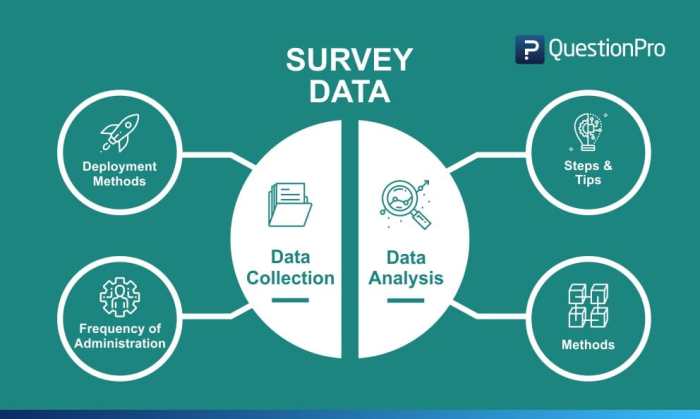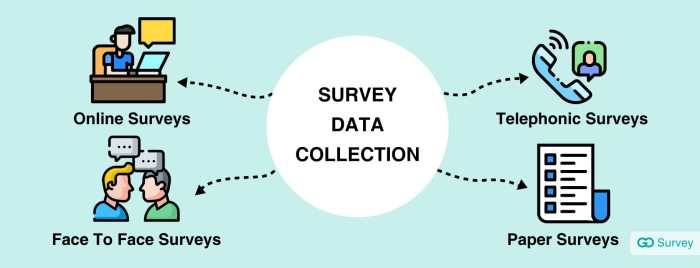Using Surveys to Collect Customer Data takes center stage, inviting you into a world of valuable insights and strategic data collection methods that successful companies swear by. Get ready to dive deep into the realm of customer feedback and data analytics.
Importance of using surveys for collecting customer data

Surveys play a crucial role in collecting customer data as they provide valuable insights into customer preferences, behaviors, and satisfaction levels. By utilizing surveys, businesses can gather accurate and relevant information directly from their target audience, allowing them to make informed decisions and tailor their products or services to meet customer needs effectively.
Effectiveness of surveys in gathering customer data
Surveys are effective in gathering customer data because they offer a structured approach to collecting information. By designing specific questions related to customer demographics, preferences, and feedback, businesses can obtain detailed insights into their target market. Surveys also allow for quantitative analysis, enabling companies to measure customer satisfaction levels, identify trends, and track changes over time.
Benefits of using surveys compared to other data collection methods
- Cost-effective: Surveys are a cost-effective way to gather customer data, especially when compared to methods like focus groups or interviews.
- Scalability: Surveys can be easily scaled to reach a large number of respondents, making them ideal for collecting data from a diverse audience.
- Anonymity: Surveys provide respondents with anonymity, encouraging honest feedback and reducing bias in the data collected.
- Data analysis: Surveys generate structured data that can be easily analyzed and used to draw actionable insights for business decision-making.
Examples of successful companies utilizing surveys for customer data collection
Companies like Amazon, Airbnb, and Starbucks have successfully utilized surveys to collect customer data and improve their services. Amazon, for instance, uses customer feedback surveys to gather insights into shopping preferences and enhance the overall shopping experience. Airbnb leverages surveys to collect feedback on guest experiences and property listings, allowing them to make data-driven decisions to enhance customer satisfaction. Starbucks uses surveys to gather feedback on new products, customer service, and store experiences, enabling them to make strategic improvements based on customer preferences and feedback.
Designing effective surveys
When it comes to collecting customer data through surveys, the design of the survey plays a crucial role in the success of the data collection process. Here are some tips and best practices for creating well-designed surveys that yield high response rates and relevant customer data.
Creating well-designed survey questions
When crafting survey questions, it’s essential to keep them clear, concise, and relevant to the information you are seeking. Avoid using jargon or complex language that may confuse respondents. Make sure each question is focused and directly contributes to the overall objective of the survey. Additionally, consider using a mix of question types such as multiple-choice, rating scales, and open-ended questions to gather diverse insights from customers.
Importance of survey structure
The structure of a survey can greatly impact the quality of data collected. Organize questions logically and ensure a flow that is easy to follow for respondents. Start with simple and engaging questions to capture attention and gradually move towards more complex or personal inquiries. By structuring the survey effectively, you can keep respondents engaged and motivated to complete the entire survey, resulting in more accurate and comprehensive data.
Ensuring high response rates
To maximize response rates, consider the length of the survey and the timing of its distribution. Keep the survey concise and focused on the most critical information to prevent respondent fatigue. Personalize survey invitations and reminders to make them more engaging and increase the likelihood of participation. Offering incentives or rewards for completing the survey can also boost response rates.
Finally, follow up with non-respondents to encourage their participation and ensure a representative sample of customer feedback.
Types of customer data to collect through surveys
Collecting customer data through surveys is crucial for businesses to understand their target audience better and make informed decisions. By identifying key customer data points, companies can tailor their products and services to meet customer needs effectively. Let’s dive into the types of customer data that can be collected through surveys.
Key Customer Data Points
- Demographic Information: Age, gender, location, income level, education, etc.
- Buying Behavior: Frequency of purchases, preferred products/services, shopping habits.
- Feedback and Satisfaction: Overall satisfaction with the product/service, feedback on customer service.
- Preferences and Interests: Personal preferences, interests, hobbies, lifestyle choices.
By collecting demographic information, businesses can segment their target audience and create personalized marketing strategies.
Determining Specific Data Needs
- Define Objectives: Clearly Artikel the goals of the survey and what specific information is needed to achieve those goals.
- Focus on Relevance: Collect data that directly impacts decision-making processes and drives business growth.
- Consider Actionability: Ensure that the data collected can be translated into actionable insights for the business.
It’s essential to ask targeted questions that align with the objectives of the survey to gather relevant and useful data.
Data Insights from Surveys
- Identifying Customer Pain Points: Understanding where customers face challenges can help businesses improve their products/services.
- Enhancing Customer Experience: Gathering feedback on customer satisfaction can lead to enhancements in the overall customer experience.
- Predicting Future Trends: Analyzing survey data can provide insights into emerging trends and customer preferences.
Customer surveys can uncover valuable insights that drive strategic decision-making and improve overall business performance.
Analyzing and interpreting survey data: Using Surveys To Collect Customer Data

After collecting customer data through surveys, the next crucial step is to analyze and interpret the responses to gain valuable insights for your business.
Process of analyzing survey responses, Using Surveys to Collect Customer Data
- Organize the data: Sort the survey responses systematically to identify patterns and trends.
- Quantitative analysis: Use statistical tools to analyze numerical data and derive quantitative insights.
- Qualitative analysis: Dive deeper into open-ended responses to understand customer sentiments and feedback.
- Compare and contrast: Look for differences and similarities in responses across different demographics or survey questions.
Tools and techniques for interpreting customer data
- Data visualization: Utilize graphs, charts, and dashboards to present survey data visually for easier interpretation.
- Text analysis tools: Use natural language processing tools to analyze text responses and extract key themes and sentiments.
- Segmentation analysis: Divide customers into distinct groups based on survey responses to tailor marketing strategies effectively.
Tips for translating raw survey data into actionable business strategies
- Focus on key metrics: Identify the most critical data points that align with your business goals and objectives.
- Look for trends: Analyze survey data over time to identify changing patterns and trends that can guide strategic decisions.
- Seek feedback: Incorporate feedback from stakeholders and team members to ensure a comprehensive understanding of the survey data.
- Iterate and refine: Continuously analyze and interpret survey data to refine your strategies and improve customer satisfaction.
